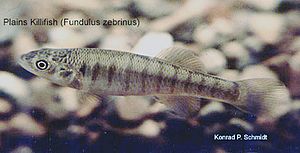Plains killifish facts for kids
Quick facts for kids Plains killifish |
|
|---|---|
 |
|
| Conservation status | |
| Scientific classification | |
| Synonyms | |
|
The plains killifish (scientific name: Fundulus zebrinus) is a type of fish found in North America. It lives in rivers, streams, and lakes, mainly in the central United States. You can find it in the Mississippi River, Colorado River, and Rio Grande areas. Sometimes, these fish are also found in new places where they were not originally from.
Contents
What Does It Look Like?
This fish is usually about 6.9 centimeters (about 2.7 inches) long. Some can grow up to 8 to 10 centimeters (about 3 to 4 inches). Most plains killifish live for about two years, but some can live up to three years.
It has a flat head and a jaw that sticks out. This helps it eat food right from the water's surface. The fish can be brown, black, green, or straw-colored. Its belly is usually lighter, like yellowish or silver.
Why Is It Called "Zebra"?
The plains killifish has 12 to 28 dark stripes that go up and down its body. These stripes make it look a bit like a zebra, which is why its scientific name means "like a zebra." Male fish have wider and darker stripes than females. When it's time to breed, male plains killifish get bright orange colors on most of their fins.
What Does It Eat?
The plains killifish eats many different things. It enjoys small animals like insect larvae, tiny crustaceans called copepods, and nematodes (small worms). It also eats plants.
Sometimes, it scoops up mouthfuls of sand or mud from the riverbed. It does this to find food that is buried there. The fish usually spits out most of the sand. However, its stomach often has some sand in it. This fish also eats mosquito larvae. Because of this, it can be helpful in controlling mosquito populations.
Where Does It Live?
This fish lives in shallow parts of rivers and streams. It can live in water that moves slowly, moderately, or quickly. It can also be found in lakes. The plains killifish is very tough. It can live in water that is a bit salty, alkaline (the opposite of acidic), or very salty. Most other local fish cannot handle these conditions as well.
Hiding in the Sand
Sometimes, the plains killifish buries itself in the sand or mud. Only its eyes and mouth stick out. It might do this when it feels stressed. Burying itself can protect it from sunlight, heat, or animals that want to eat it. It also helps when water levels are low. This behavior might even help it get rid of parasites. Other fish, like the green sunfish, sometimes eat plains killifish. When green sunfish are around, the number of killifish can go down.
Reproduction
Plains killifish start to lay their eggs, a process called spawning, when the water gets warm. This usually happens when the water temperature is above 26 degrees Celsius (about 79 degrees Fahrenheit). The spawning season typically begins in April and continues through August.
Where Are They Found?
The plains killifish lives across a wide area, mostly in the central United States. Its natural home is mainly in the Great Plains. This includes much of the Mississippi River area, parts of the Colorado and Brazos Rivers, and some areas near the Rio Grande, especially the Pecos River.
How They Spread
The way these fish are spread was affected by changes in river systems long ago, like during the Ice Age. Many places where you find this fish today are not its original home. For example, there are populations in Lake Powell in Arizona and Utah, and in the Fort Peck Reservoir in Montana. They are also in parts of the Colorado River in Colorado, Utah, and Nevada.
Fish started to be introduced to new places around the 1930s. This often happened when people used plains killifish as bait for fishing. If the fish escaped, they could start new groups in the wild.
Plains Killifish vs. Fundulus kansae
For a long time, another fish called Fundulus kansae was thought to be the same as the plains killifish. People even thought their names were synonyms. Sometimes, F. kansae was even called a subspecies of F. zebrinus.
However, studies of their DNA showed that they are actually different species. F. zebrinus is a bit bigger than F. kansae. It also has larger scales and bigger eyes. When male F. zebrinus are breeding, their fins turn more red. Male F. kansae fins turn more yellow-orange.
See also
 In Spanish: Fundulus zebrinus para niños
In Spanish: Fundulus zebrinus para niños



